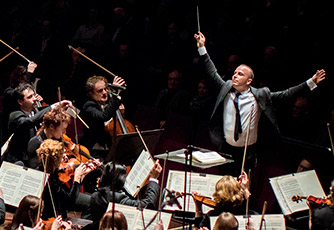October has been a very exciting month for orchestra lovers; from the New York Philharmonic’s residency in Ann Arbor earlier this month to this performance by the Chicago Symphony Orchestra, we have not been disappointed.
A bit of bragging moment: earlier that day, I had an opportunity to play for Dwight Parry, an oboist from Cincinnati Symphony Orchestra who has been touring with the Chicago Symphony Orchestra as the principal oboe. He was very inspirational — with much focus on technique as well as musicality, I learned a lot from him. Here’s a proof:

As a orchestral musician, Mr. Parry has a lot of experience in auditioning and judging auditions. Many of us classical musicians stress over the whole audition process all the time. Winning a position in an orchestra through auditions is extremely difficult — with hundreds of well-qualified applicants fighting over one seat, which is typically to be filled for decades once someone wins the spot. He mentioned that, when he is judging auditions, he is looking for a “colleague” — someone that can play in tune and in tempo, and that is overall pleasant to work with. These words stuck out to me as a lesson.
After that interaction with Mr. Parry, seeing him among many other superb musicians of the Chicago Symphony Orchestra made me feel much closer to the orchestra. And I thought a lot about colleagues in an ensemble. What does it mean to play with the same people on your left and on your right for many, many years? Ideally, these players would develop the chemistry among them that make the “group” sound instead of “individual” sounds. However, this is not always the case, as conflicts and drama do happen. How do you act professional and deliver high-quality music to the audience with your colleagues?
To me, CSO seemed to do this very well. From the first “overture” — “The Victors” — to the last movement of Mahler’s First Symphony, the chemistry was there. (Has “The Victors” become a new tradition for all orchestras visiting Ann Arbor to play?) Beethoven’s Fifth Symphony (with the iconic “duh-duh-duh-dummmmm” in the first movement) and Mahler’s First Symphony (with full of contrasts and shining moments for all instruments) are both classic favorites, and CSO gave no less than spectacular.
UMS has two more (international!) orchestras coming this season: Royal Philharmonic Orchestra from London in January, and Montreal Symphony Orchestra from Quebec in March. I am very much looking forward to exploring more orchestral artistry in the upcoming months.



 When: Sunday, October 27th, 4:30pm
When: Sunday, October 27th, 4:30pm